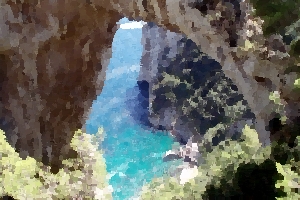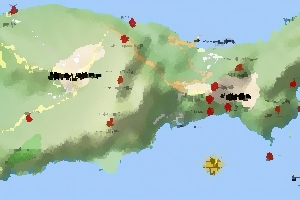The very touristy island of Capri is located in the Bay of Naples, opposite the Sorrento peninsula. This name is also given to the largest town on the island. It is easily reached by boat in 20 minutes for a relaxing getaway. The climate, the serene sky, the charm of the landscape and the many attractions make this island the most beautiful tourist destination in any season.
Capri is perhaps one of the first tourist destinations in history. Already during the Roman Empire, it was the delight of emperors who came to stay for a while on the island. Centuries later, cinema and literature have once again elevated its cliffs, steep hills and caves to an acclaimed destination of the richest.
Capri with the islands of Procida and Ischia are the main islands off Naples. Ponza, Palmarola, Gavi and Zannone belong to the Pontine Islands in the Tyrrhenian Sea.
A colorful island
 A rocky arch overlooking a small bay in Capri. [CC] credit.
A rocky arch overlooking a small bay in Capri. [CC] credit.The island of Capri is about six kilometres long and three kilometres wide, with an area of 10 square kilometres. Like many Italian islands, it has beautiful beaches set in steep cliffs. The highest peak is Mount Solaro, 589 metres high.
Capri is also known for its Faraglioni, three thousand-year-old rocks that are set in the sea. This exceptional setting promises beautiful walks in the heart of dense and luxuriant vegetation, whose reflections shimmer in the turquoise water.
Short History
Inhabited since the Paleolithic age, the island was first Greek and then Roman. Visiting Capri in 29 BC, Caesar Augustus was so struck by its incomparable beauty that he bought it from the city of Naples in exchange for the larger and richer neighbouring island of Ischia. His successor, Tiberius, stayed there from 27 to 36 AD and had 12 villas built, dedicated to as many Olympian deities. It was from the most imposing of these, Villa Jovis, that he ruled the Roman Empire. Other emperors stayed in Capri after Tiberius and it was visited and inhabited by Roman nobles until the 4th century AD.
The island came under the control of the Duchy of Naples again, and from the 6th to the 7th century it was subjected to Saracen incursions, then to the domination of the Lombards, the Normans (1200), the Angevins (1300), the Aragonese (1400), the Spaniards (1500), the Austrians (1600), the French (1700) and the English (1800).
From 1800 onwards, artists, writers, poets and others began to flock to Capri, attracted by its harmonious beauty and pleasant, healthy climate (in February, the coldest month, the average temperature is 9°, while in the hottest month, August, it is 23.7°). Capri has a very interesting flora which, in a very small area (about 10 km2), has 850 species and 133 varieties.
Things to see and do in Capri
 A map of the attractions on the island of Capri. [CC] credit.
A map of the attractions on the island of Capri. [CC] credit.There is no shortage of activities for a few days' excursion to Capri:
- The waters are turquoise and the beaches are heavenly. The warm sand of the Marina Piccola bay can be enjoyed in mid-season, and in summer you can take refuge in a nearby cove.
- If you are looking for thrills, you can enjoy original escapades in the Grotta Azzurra (Blue grotto) or take the chairlift to Mount Solaro.
- The hiking trails offer superb views of the green cliffs and the Bay of Naples in the distance. Enjoy the view from the belvedere of Tragara.
- Dream in front of Malaparte's contemporary villa. Stroll through the gardens of San Michele and explore the ruins of the Roman imperial villas.
- Finally, enjoy the local specialities, including the famous Caprese salad with tomatoes, mozzarella, a pinch of oregano and a few basil leaves.
The towns of Capri and Anacapri
Officially, the island is home to 7,400 inhabitants, but this number multiplies greatly during the summer. By boat from Naples you will arrive at Marina Grande, a pretty fishing port unfortunately overrun by tourist shops.
Practical information on the island of Capri
The town of Capri, famous for its pretty coloured houses perched on the side of the mountain, is situated about 2 km away. You can walk along the winding lanes and enjoy stopping on a sunny terrace a little way back.
Further east is Anacapri, a beautiful village perched at an altitude of 275 metres. Its oriental-style villas are cubic in shape, whitewashed and sometimes topped with a cupola.